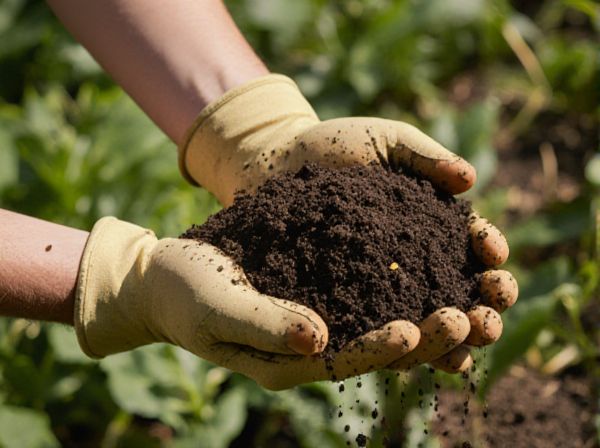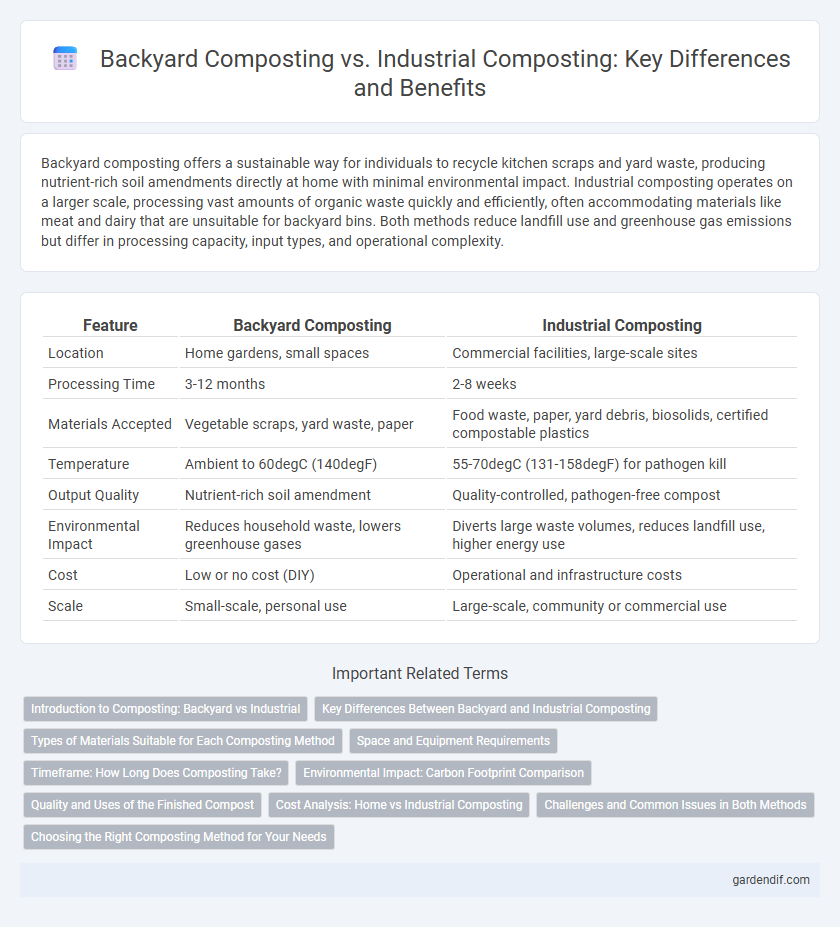
Backyard Composting vs Industrial Composting Illustration
Backyard composting offers a sustainable way for individuals to recycle kitchen scraps and yard waste, producing nutrient-rich soil amendments directly at home with minimal environmental impact. Industrial composting operates on a larger scale, processing vast amounts of organic waste quickly and efficiently, often accommodating materials like meat and dairy that are unsuitable for backyard bins. Both methods reduce landfill use and greenhouse gas emissions but differ in processing capacity, input types, and operational complexity.
Table of Comparison
| Feature | Backyard Composting | Industrial Composting |
|---|---|---|
| Location | Home gardens, small spaces | Commercial facilities, large-scale sites |
| Processing Time | 3-12 months | 2-8 weeks |
| Materials Accepted | Vegetable scraps, yard waste, paper | Food waste, paper, yard debris, biosolids, certified compostable plastics |
| Temperature | Ambient to 60degC (140degF) | 55-70degC (131-158degF) for pathogen kill |
| Output Quality | Nutrient-rich soil amendment | Quality-controlled, pathogen-free compost |
| Environmental Impact | Reduces household waste, lowers greenhouse gases | Diverts large waste volumes, reduces landfill use, higher energy use |
| Cost | Low or no cost (DIY) | Operational and infrastructure costs |
| Scale | Small-scale, personal use | Large-scale, community or commercial use |
Introduction to Composting: Backyard vs Industrial
Backyard composting transforms household organic waste into nutrient-rich soil amendments through natural decomposition, promoting waste reduction and garden health on a small scale. Industrial composting processes large volumes of organic material, including food scraps and yard waste, using controlled conditions that accelerate decomposition and ensure pathogen elimination. Both methods contribute to sustainable waste management, but differ significantly in scale, technology, and processing time.
Key Differences Between Backyard and Industrial Composting
Backyard composting involves small-scale organic waste decomposition using household scraps, garden waste, and limited materials, producing nutrient-rich compost for personal use within weeks to months. Industrial composting operates on a large scale, processing diverse organic waste including food waste and biosolids at higher temperatures, accelerating decomposition and killing pathogens more effectively. Key differences include scale, temperature control, composting speed, and the range of accepted materials, with industrial composting offering a more controlled, efficient, and broad-spectrum waste management solution.
Types of Materials Suitable for Each Composting Method
Backyard composting is ideal for organic kitchen scraps such as fruit and vegetable peels, coffee grounds, eggshells, and yard waste like grass clippings and leaves, which easily decompose in small-scale setups. Industrial composting can handle a broader range of materials including meat, dairy products, and treated wood, due to its higher temperatures and controlled environment that break down tougher and potentially hazardous waste. Both methods effectively recycle organic matter but differ significantly in the types of materials they accommodate based on processing capabilities.
Space and Equipment Requirements
Backyard composting requires minimal space, typically a small bin or pile in a garden, making it accessible for most households with limited outdoor areas. It relies on basic equipment such as a compost bin, garden fork, and occasional turning tools, allowing for low-cost and low-maintenance compost production. In contrast, industrial composting facilities need extensive space to accommodate large-scale operations and advanced machinery like aeration systems, shredders, and temperature controls to efficiently process vast quantities of organic waste.
Timeframe: How Long Does Composting Take?
Backyard composting typically takes between three to six months, depending on the materials used, moisture levels, and aeration. Industrial composting accelerates this process to as little as two to eight weeks by maintaining optimal temperatures above 55degC and actively managing microbial activity. Timeframe differences are crucial for selecting composting methods based on urgency, scale, and waste type.
Environmental Impact: Carbon Footprint Comparison
Backyard composting significantly reduces carbon footprints by minimizing transportation emissions and utilizing organic waste on-site, which enhances soil carbon sequestration. Industrial composting, although capable of processing larger volumes and achieving higher temperatures to break down pathogens, involves energy-intensive machinery and transport logistics that contribute to higher greenhouse gas emissions. Overall, backyard composting offers a more sustainable environmental impact for local waste management and carbon reduction.
Quality and Uses of the Finished Compost
Backyard composting typically produces nutrient-rich compost with a balanced mix of organic matter, beneficial microbes, and earthworm castings, ideal for garden use and improving soil texture. Industrial composting often yields a more uniform, pathogen-free product through controlled high-temperature processes, making it suitable for large-scale agriculture and commercial landscaping. Both methods create valuable soil amendments, but industrial compost's consistency and safety standards enable broader applications in regulated environments.
Cost Analysis: Home vs Industrial Composting
Home composting reduces costs significantly by utilizing household organic waste, requiring minimal investment in bins or tumblers, and eliminating waste collection fees. Industrial composting involves higher expenses due to large-scale equipment, transportation, labor, and facility management, but benefits from economies of scale and processing diverse waste streams. Cost analysis reveals home composting is more economical for households, while industrial composting supports municipal waste management and handles volumes unmanageable by individual efforts.
Challenges and Common Issues in Both Methods
Backyard composting often faces challenges such as limited space, inconsistent temperature control, and pest management issues, which can slow down the decomposition process. Industrial composting, while more efficient, encounters problems with contamination from non-compostable materials, the high energy required for aeration, and difficulties in managing large-scale odour emissions. Both methods struggle with maintaining optimal moisture levels and balancing carbon-to-nitrogen ratios to ensure effective organic waste breakdown.
Choosing the Right Composting Method for Your Needs
Backyard composting offers a sustainable solution for households seeking to recycle kitchen scraps and yard waste, providing nutrient-rich soil for personal gardens with minimal environmental impact. Industrial composting, on the other hand, handles large-scale organic waste efficiently, processing materials like food packaging and biosolids that require higher temperatures to break down safely. Selecting the right composting method depends on factors such as the volume of waste, available space, desired compost quality, and specific organic materials involved.
Backyard Composting vs Industrial Composting Infographic

 gardendif.com
gardendif.com